TOYOTA YARIS GRMN 2017 Owners Manual
Manufacturer: TOYOTA, Model Year: 2017, Model line: YARIS GRMN, Model: TOYOTA YARIS GRMN 2017Pages: 404, PDF Size: 54.2 MB
Page 361 of 404
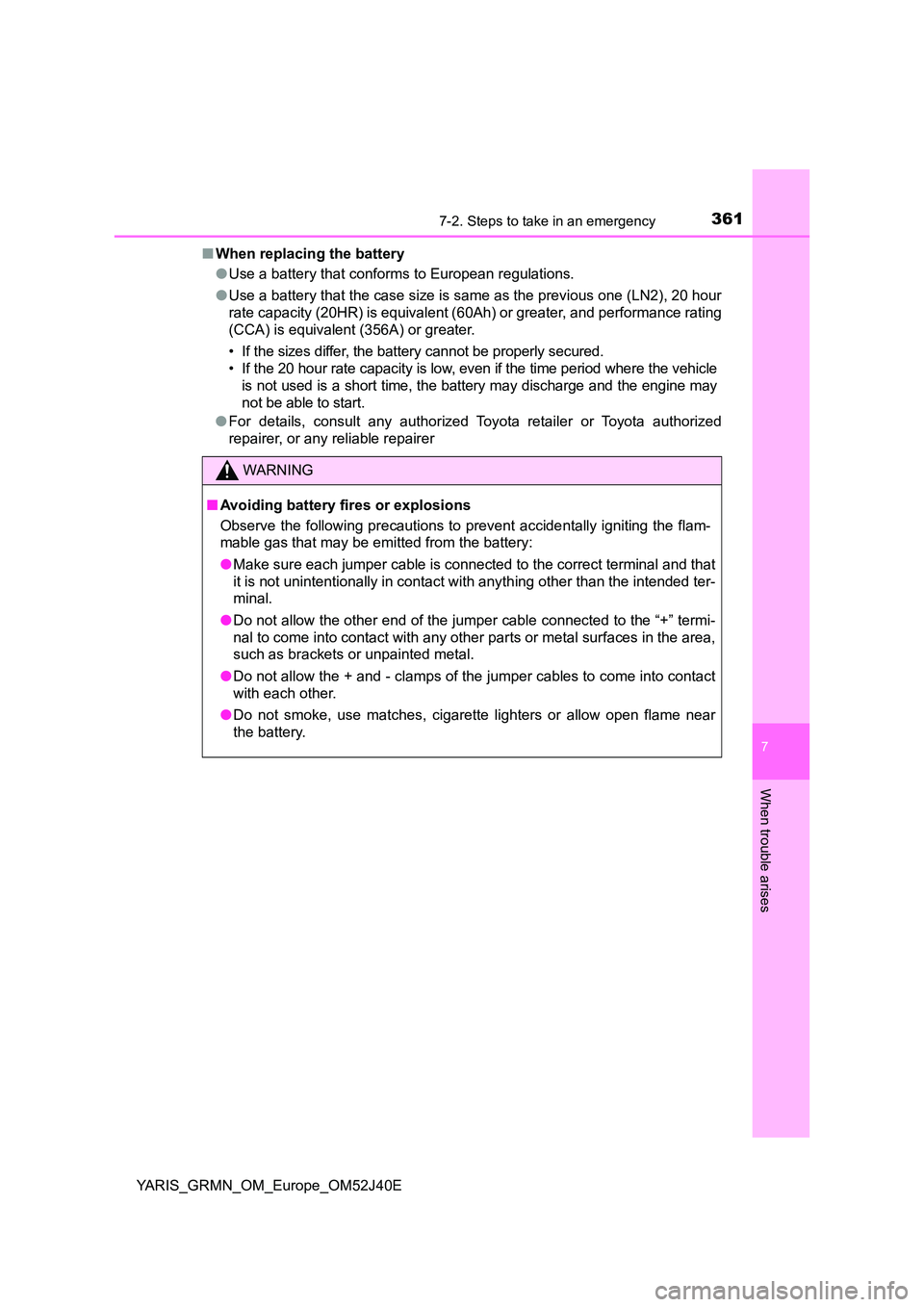
3617-2. Steps to take in an emergency
YARIS_GRMN_OM_Europe_OM52J40E
7
When trouble arises
■When replacing the battery
● Use a battery that conforms to European regulations.
● Use a battery that the case size is same as the previous one (LN2), 20 hour
rate capacity (20HR) is equivalent (60Ah) or greater, and performance rating
(CCA) is equivalent (356A) or greater.
• If the sizes differ, the battery cannot be properly secured.
• If the 20 hour rate capacity is low, even if the time period where the vehicle
is not used is a short time, the battery may discharge and the engine may
not be able to start.
● For details, consult any authorized Toyota retailer or Toyota authorized
repairer, or any reliable repairer
WARNING
■ Avoiding battery fires or explosions
Observe the following precautions to prevent accidentally igniting the flam-
mable gas that may be emitted from the battery:
● Make sure each jumper cable is connected to the correct terminal and that
it is not unintentionally in contact with anything other than the intended ter-
minal.
● Do not allow the other end of the jumper cable connected to the “+” termi-
nal to come into contact with any other parts or metal surfaces in the area,
such as brackets or unpainted metal.
● Do not allow the + and - clamps of the jumper cables to come into contact
with each other.
● Do not smoke, use matches, cigarette lighters or allow open flame near
the battery.
Page 362 of 404
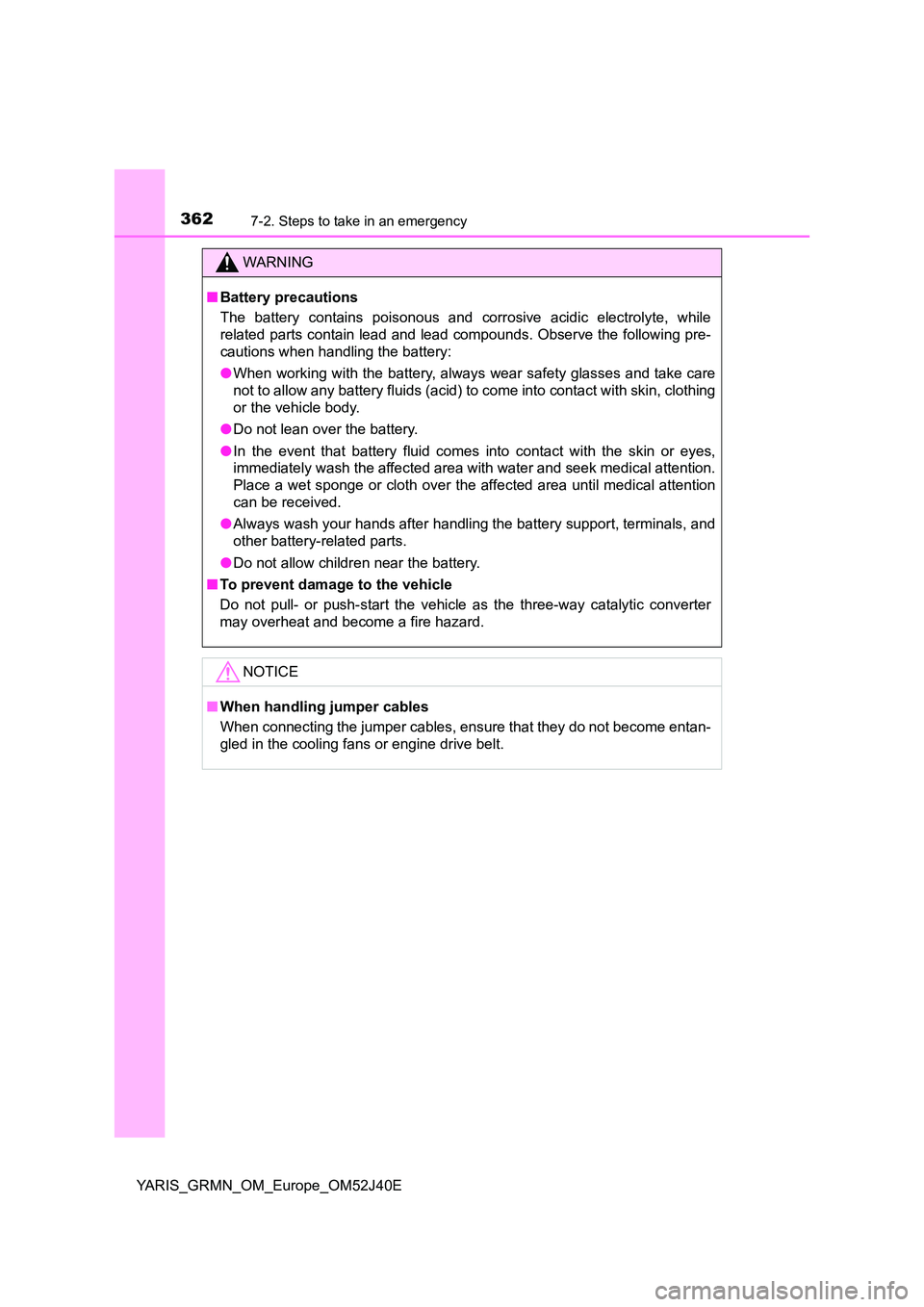
3627-2. Steps to take in an emergency
YARIS_GRMN_OM_Europe_OM52J40E
WARNING
■Battery precautions
The battery contains poisonous and corrosive acidic electrolyte, while
related parts contain lead and lead compounds. Observe the following pre-
cautions when handling the battery:
● When working with the battery, always wear safety glasses and take care
not to allow any battery fluids (acid) to come into contact with skin, clothing
or the vehicle body.
● Do not lean over the battery.
● In the event that battery fluid comes into contact with the skin or eyes,
immediately wash the affected area with water and seek medical attention.
Place a wet sponge or cloth over the affected area until medical attention
can be received.
● Always wash your hands after handling the battery support, terminals, and
other battery-related parts.
● Do not allow children near the battery.
■ To prevent damage to the vehicle
Do not pull- or push-start the vehicle as the three-way catalytic converter
may overheat and become a fire hazard.
NOTICE
■ When handling jumper cables
When connecting the jumper cables, ensure that they do not become entan-
gled in the cooling fans or engine drive belt.
Page 363 of 404

3637-2. Steps to take in an emergency
YARIS_GRMN_OM_Europe_OM52J40E
7
When trouble arises
If your vehicle overheats
●The needle of the engine coolant temperature gauge (P. 9 6 )
enters the red zone or a loss of engine power is experienced.
(For example, the vehicles speed does not increase.)
● The warning message indicating overheat is shown on the multi-
information display. ( P. 332)
● Steam comes out from under the hood.
Stop the vehicle in a safe place and turn off the air conditioning sys-
tem, and then stop the engine.
If you see steam:
Carefully lift the hood after the steam subsides.
If you do not see steam:
Carefully lift the hood.
The following may indicate that your vehicle is overheating:
Correction procedures
Page 364 of 404
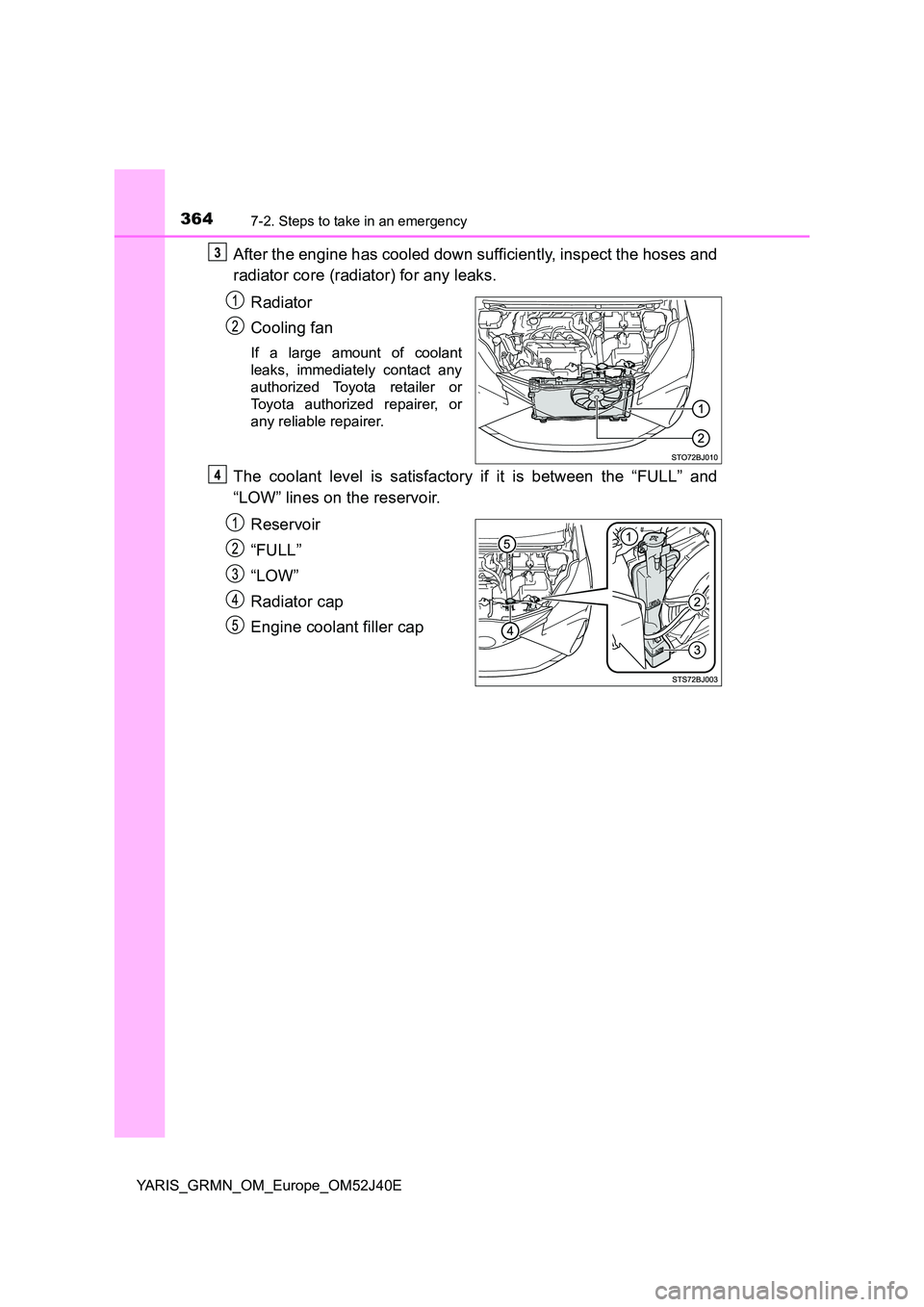
3647-2. Steps to take in an emergency
YARIS_GRMN_OM_Europe_OM52J40E
After the engine has cooled down sufficiently, inspect the hoses and
radiator core (radiator) for any leaks.
Radiator
Cooling fan
If a large amount of coolant
leaks, immediately contact any
authorized Toyota retailer or
Toyota authorized repairer, or
any reliable repairer.
The coolant level is satisfactory if it is between the “FULL” and
“LOW” lines on the reservoir.
Reservoir
“FULL”
“LOW”
Radiator cap
Engine coolant filler cap
Page 365 of 404
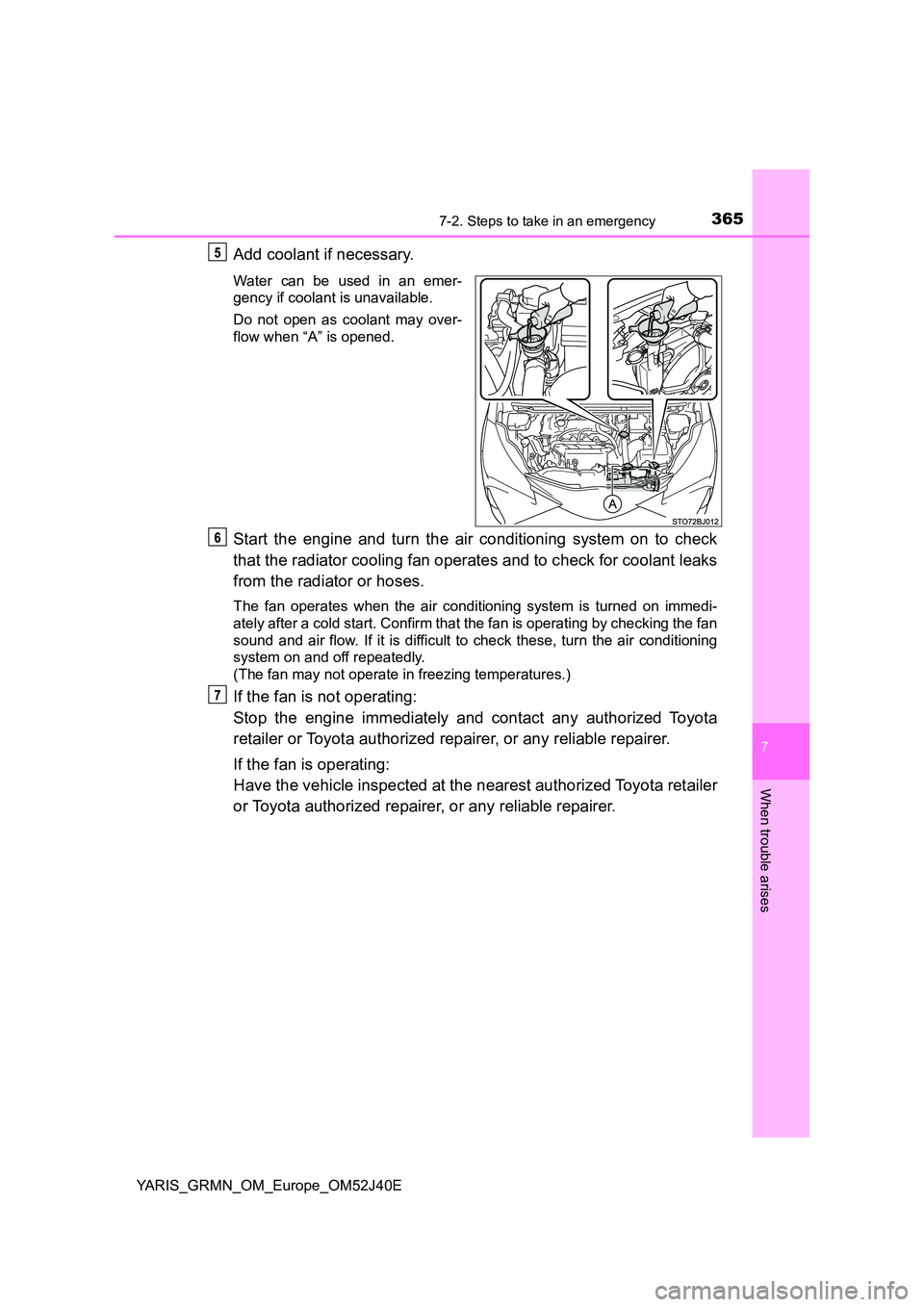
3657-2. Steps to take in an emergency
YARIS_GRMN_OM_Europe_OM52J40E
7
When trouble arises
Add coolant if necessary.
Water can be used in an emer-
gency if coolant is unavailable.
Do not open as coolant may over-
flow when “A” is opened.
Start the engine and turn the air conditioning system on to check
that the radiator cooling fan operates and to check for coolant leaks
from the radiator or hoses.
The fan operates when the air conditioning system is turned on immedi-
ately after a cold start. Confirm that the fan is operating by checking the fan
sound and air flow. If it is difficult to check these, turn the air conditioning
system on and off repeatedly.
(The fan may not operate in freezing temperatures.)
If the fan is not operating:
Stop the engine immediately and contact any authorized Toyota
retailer or Toyota authorized repairer, or any reliable repairer.
If the fan is operating:
Have the vehicle inspected at the nearest authorized Toyota retailer
or Toyota authorized repairer, or any reliable repairer.
Page 366 of 404
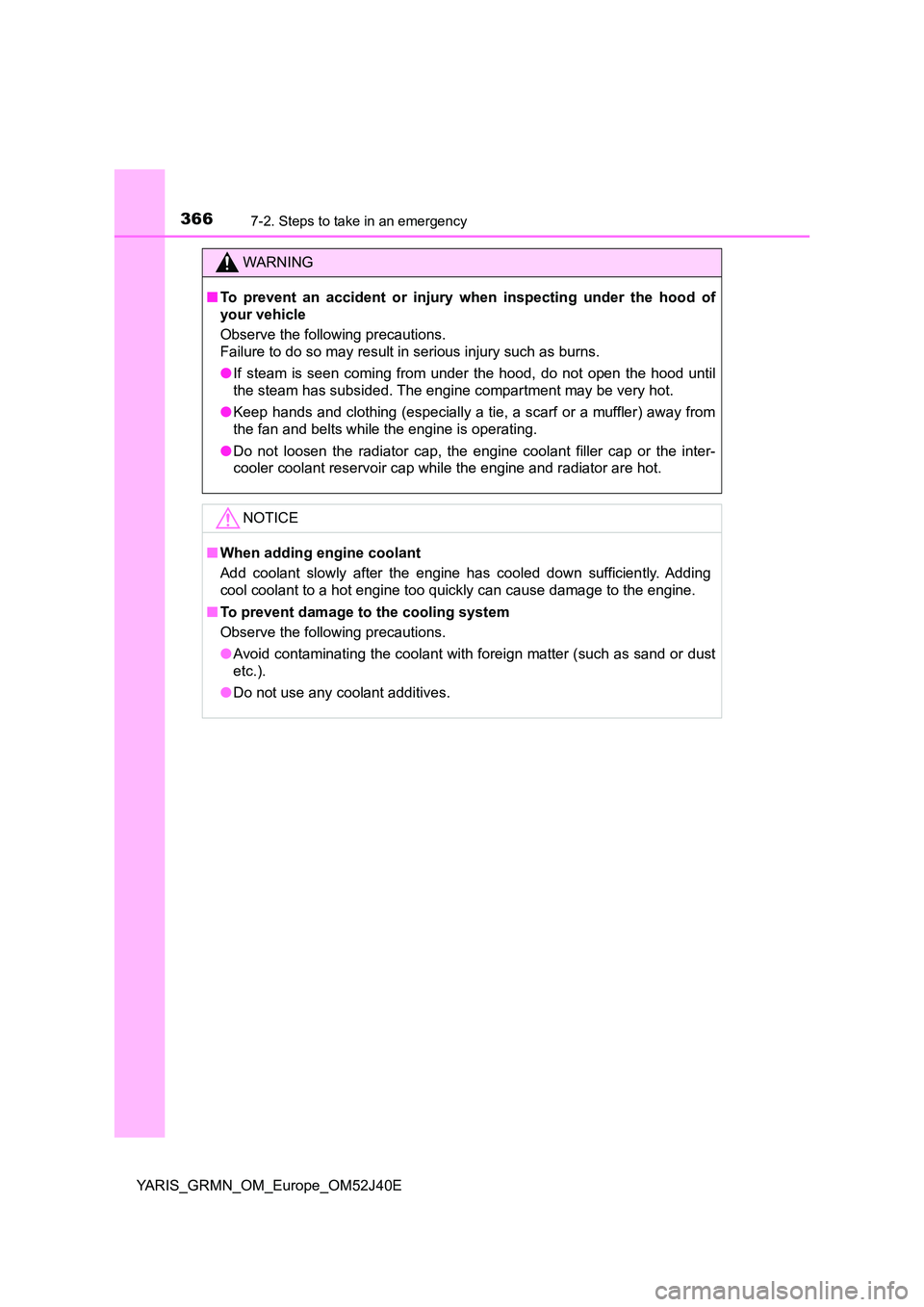
3667-2. Steps to take in an emergency
YARIS_GRMN_OM_Europe_OM52J40E
WARNING
■To prevent an accident or injury when inspecting under the hood of
your vehicle
Observe the following precautions.
Failure to do so may result in serious injury such as burns.
● If steam is seen coming from under the hood, do not open the hood until
the steam has subsided. The engine compartment may be very hot.
● Keep hands and clothing (especially a tie, a scarf or a muffler) away from
the fan and belts while the engine is operating.
● Do not loosen the radiator cap, the engine coolant filler cap or the inter-
cooler coolant reservoir cap while the engine and radiator are hot.
NOTICE
■ When adding engine coolant
Add coolant slowly after the engine has cooled down sufficiently. Adding
cool coolant to a hot engine too quickly can cause damage to the engine.
■ To prevent damage to the cooling system
Observe the following precautions.
● Avoid contaminating the coolant with foreign matter (such as sand or dust
etc.).
● Do not use any coolant additives.
Page 367 of 404
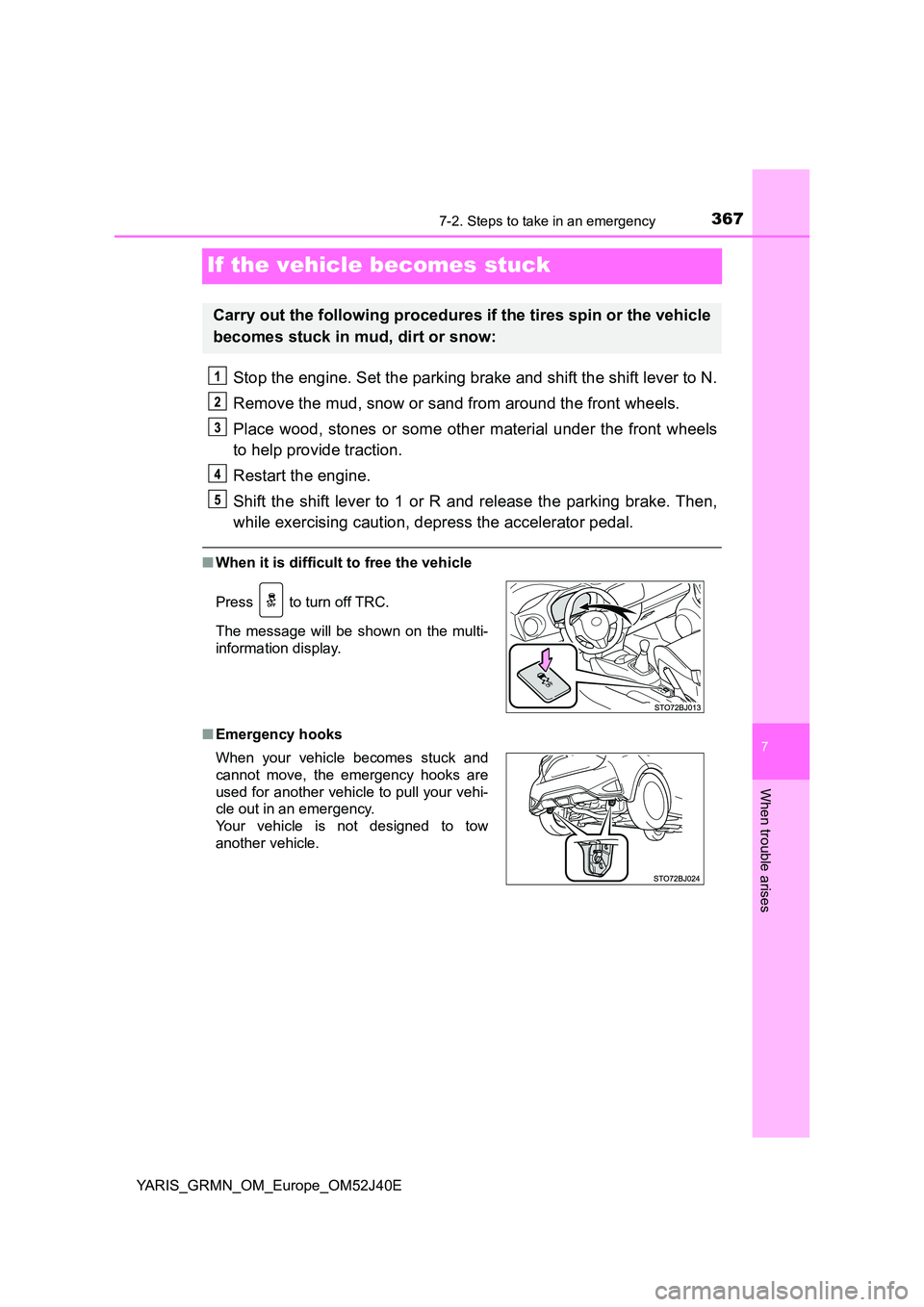
3677-2. Steps to take in an emergency
YARIS_GRMN_OM_Europe_OM52J40E
7
When trouble arises
If the vehicle becomes stuck
Stop the engine. Set the parking brake and shift the shift lever to N.
Remove the mud, snow or sand from around the front wheels.
Place wood, stones or some other material under the front wheels
to help provide traction.
Restart the engine.
Shift the shift lever to 1 or R and release the parking brake. Then,
while exercising caution, depress the accelerator pedal.
■ When it is difficult to free the vehicle
■ Emergency hooks
Carry out the following procedures if the tires spin or the vehicle
becomes stuck in mud, dirt or snow:
Press to turn off TRC.
The message will be shown on the multi-
information display.
When your vehicle becomes stuck and
cannot move, the emergency hooks are
used for another vehicle to pull your vehi-
cle out in an emergency.
Your vehicle is not designed to tow
another vehicle.
Page 368 of 404
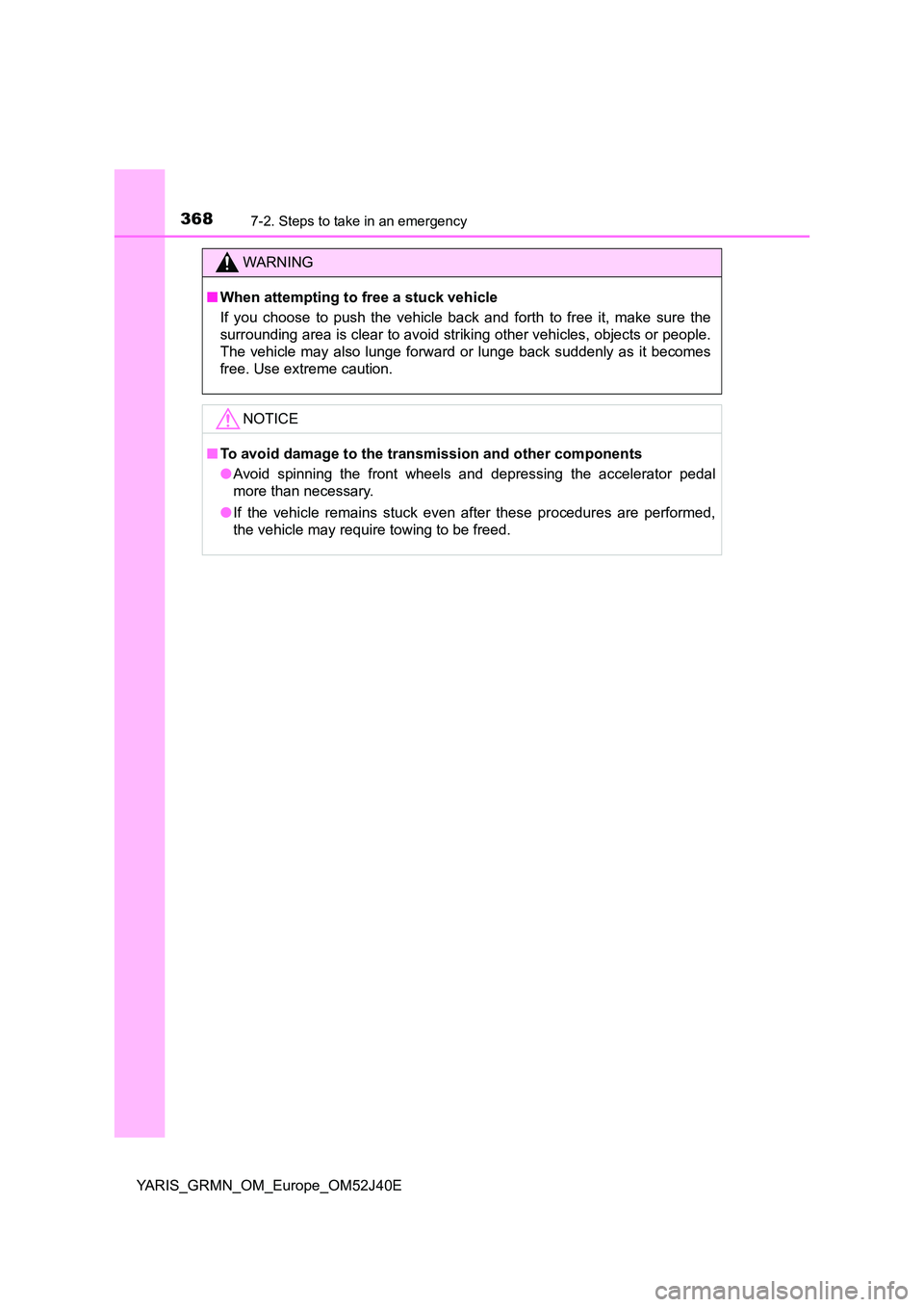
3687-2. Steps to take in an emergency
YARIS_GRMN_OM_Europe_OM52J40E
WARNING
■When attempting to free a stuck vehicle
If you choose to push the vehicle back and forth to free it, make sure the
surrounding area is clear to avoid striking other vehicles, objects or people.
The vehicle may also lunge forward or lunge back suddenly as it becomes
free. Use extreme caution.
NOTICE
■ To avoid damage to the transmission and other components
● Avoid spinning the front wheels and depressing the accelerator pedal
more than necessary.
● If the vehicle remains stuck even after these procedures are performed,
the vehicle may require towing to be freed.
Page 369 of 404
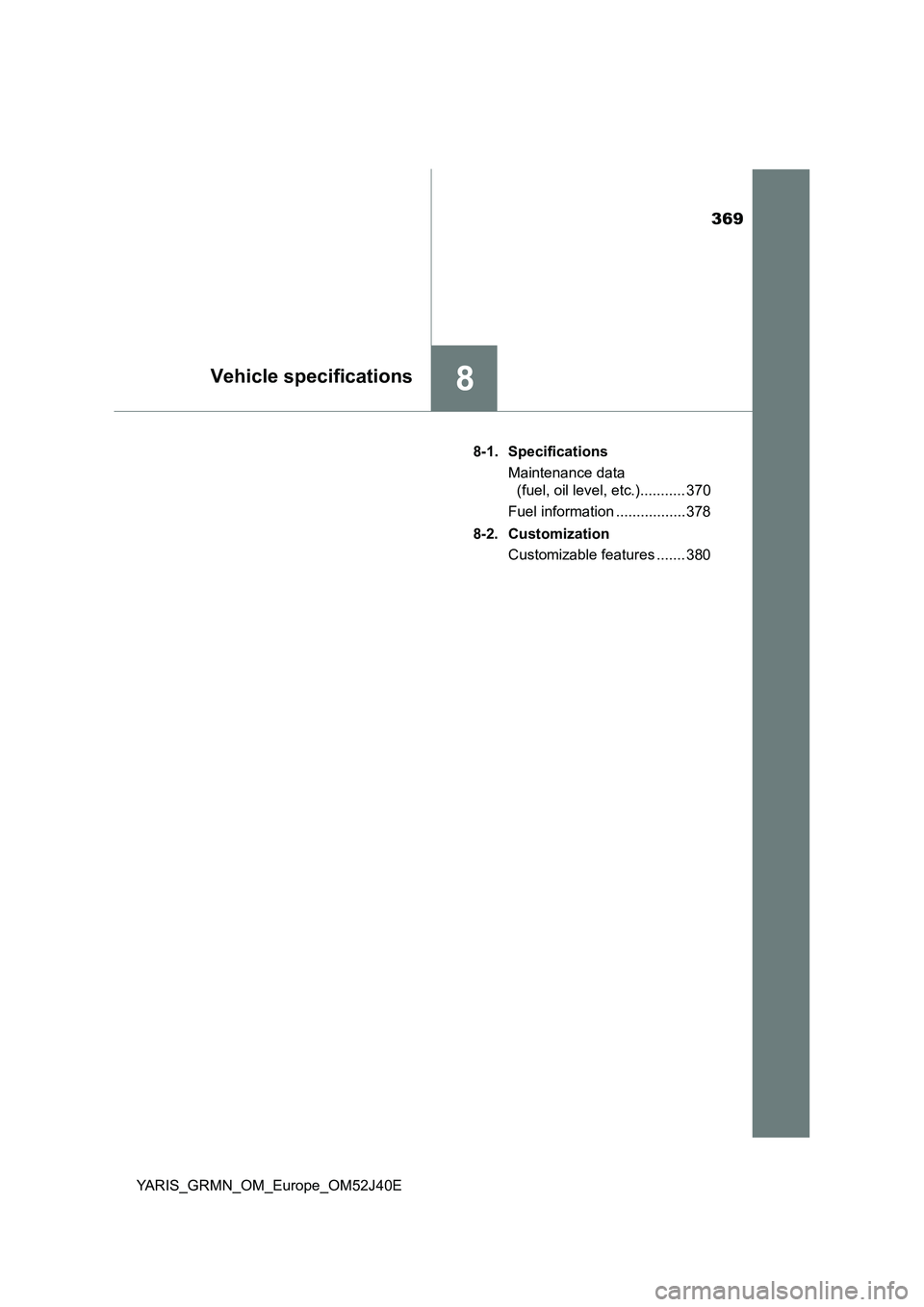
369
8Vehicle specifications
YARIS_GRMN_OM_Europe_OM52J40E
8-1. Specifications
Maintenance data
(fuel, oil level, etc.)........... 370
Fuel information ................. 378
8-2. Customization
Customizable features ....... 380
Page 370 of 404
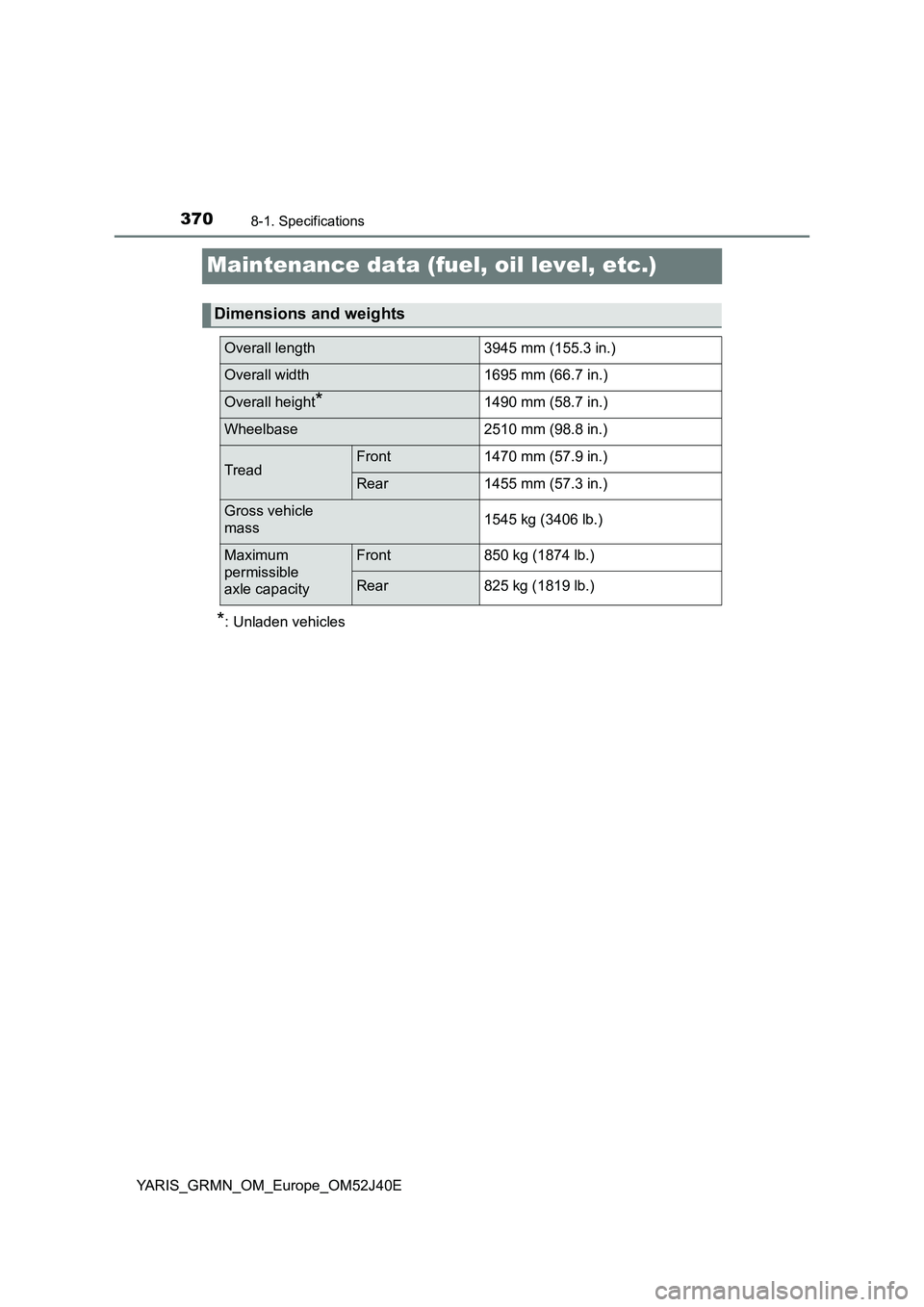
3708-1. Specifications
YARIS_GRMN_OM_Europe_OM52J40E
Maintenance data (fuel, oil level, etc.)
*: Unladen vehicles
Dimensions and weights
Overall length 3945 mm (155.3 in.)
Overall width 1695 mm (66.7 in.)
Overall height*1490 mm (58.7 in.)
Wheelbase 2510 mm (98.8 in.)
TreadFront 1470 mm (57.9 in.)
Rear 1455 mm (57.3 in.)
Gross vehicle
mass 1545 kg (3406 lb.)
Maximum
permissible
axle capacity
Front 850 kg (1874 lb.)
Rear 825 kg (1819 lb.)